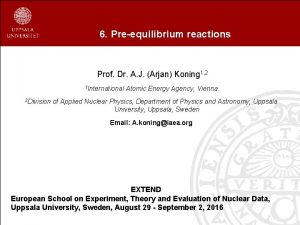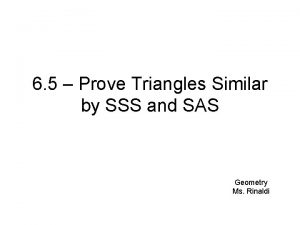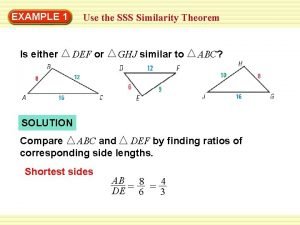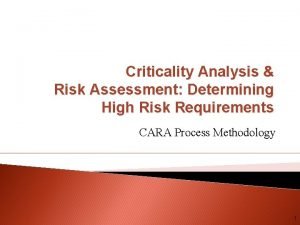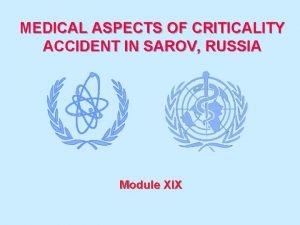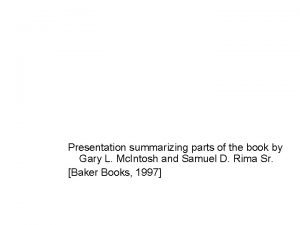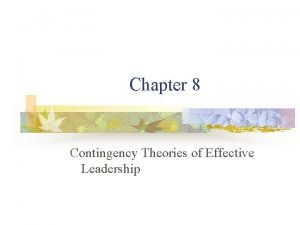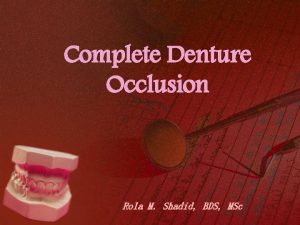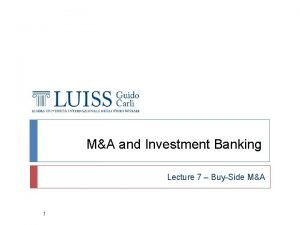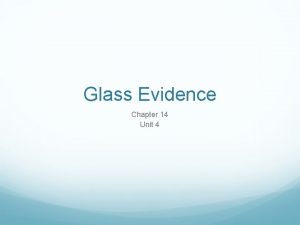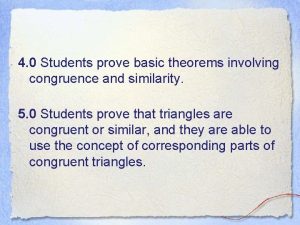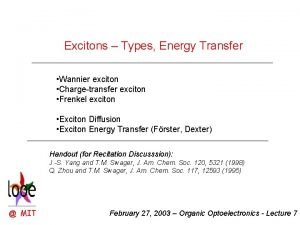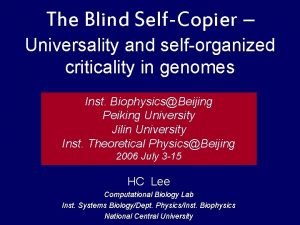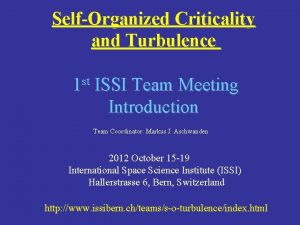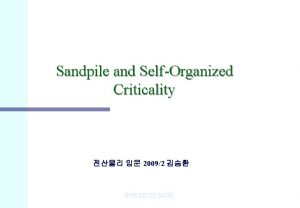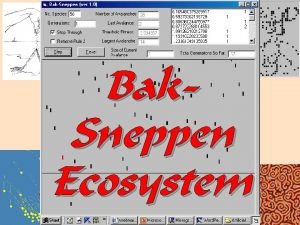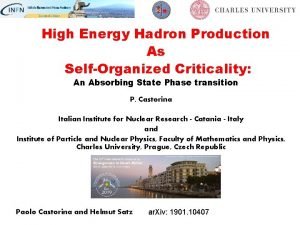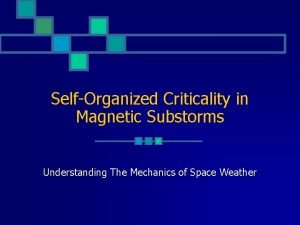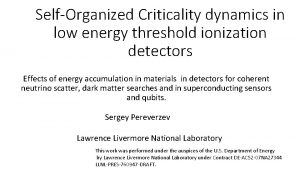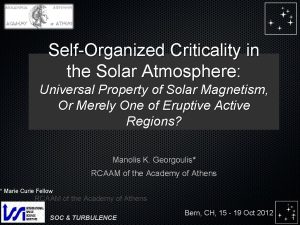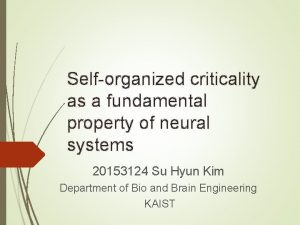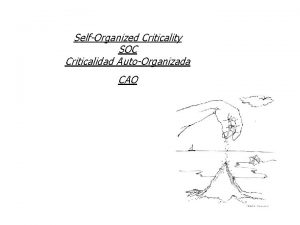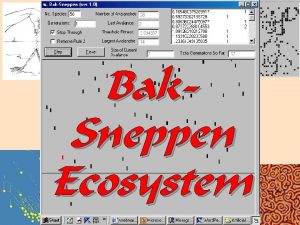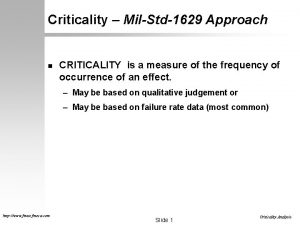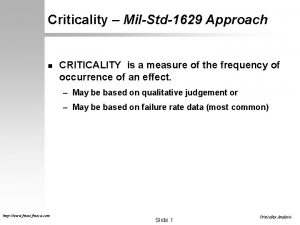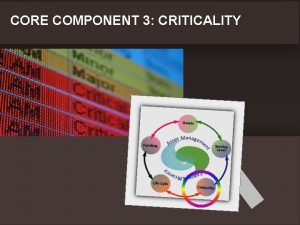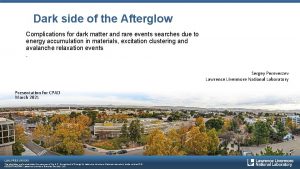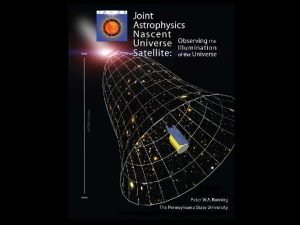Dark side of the exciton selforganized criticality and
























- Slides: 24

Dark side of the exciton: self-organized criticality and low energy threshold detectors. S. Pereverzev, A. Bernstein. LLNL This work was performed under the auspices of the U. S. Department of Energy by Lawrence Livermore National Laboratory under Contract DE-AC 52 -07 NA 27344 LLNL-PRES-760947 -DRAFT.

Xe detector low/ high background A Xe 10 – underground “Flat” residual background- low angle Compton scattering 2010 Sorensen paper Red curve- detector-produced components of background -our hypothesis B Xe detector (prototype of Zeplin) operating in reactor building in MEPHI Private communication from Dmitry Akimov, RED (Russian Emission Detetctor) group, Moscow Low energy gammas or electrons can not penetrate deep inside Xe (Ar) because of self –shielding Some detector-generated background should be present

Ar detector low and high background Dark Side 50 2018 ar. Xiv paper; underground measurements Same unexplained rise of background at small energies Livermore Ar detector experiments Sangiorgio NIM paper, First Ar 37 L-shell 0, 27 ke. V detection/ calibration Low energy background in few electrons signal range in underground experiments is sufficiently low to detect neutrinos from GW power reactor at 25 m from the core. But what is the source of this background? Can we suppress it 3 -4 orders of magnitude for detectors at the surface?

Dual phase detector / time projection chamber Photo-multipliers (PMTs) Gas “secondary” Anode grid HV Extraction grid Radiation Liquid “primary” HV e- e- Few electron-ion pairs limit- S 2 analysis only (no Z coordinate of events) up to single electron sensitivity e- Photo-multipliers (PMTs) Cathode grid Usual assumption- positive ions recombine at cathode grid upon arrival -?

Three-phase detector: Solid multilayer physiosorbed films present on surfaces Sorption diagram from review paper L. W. Bruch, R. D. Diehl, J. A. Venables, “Progress in the measurement and modeling of physiosorbed layers”, Reviews of Modern Physics, V. 79, pp. 1381 -1454, (2007). Noble gases always from solid dielectric film on cold metal surfaces Ions can be trapped by solid layers

The model • Localized ions/ long-living excitons are produced in ionization events and are accumulating in solid films on electrodes. • Events of chain recombination of ions/ excitons result in bursts of electron emission (1, 2, 3, …, n electrons per event). • So, we have Self-Organized Criticality dynamics This model provides a unified “big picture” of a wide range of effects (see below)

General theoretical framework Scientific American, Vol 254, pp. 46 -53 (1991) “excitations” are slowly produced, accumulate and annihilate in avalanche- like events. Classical “soft condensed matter” problem : grows of sand pile, when material is added to the top and spreads horizontally by avalanches. Applicable to “hardcore condensed matter”- crack formation, motion of quantized vortexes in superconductor, some interacting spin systems (not all interactions results in SOC), etc. Many features of Self-Organized Criticality are universal and do not depend on details of interactions

Self-Organized Criticality - properties Probability of large avalanche is decreasing polynomially with energy: polynomial (not exponential) events spectrum, probability of a catastrophic event not negligible Noise spectrum close to 1/f “Energy up-conversion events”- even when low energy events produce excitations, “large events” are possible Probability of large event can be suppressed by reinforcing relaxation at small scale- • For sand, put sand pile on vibrating platform • For solid nobles on metal, force recombination of trapped ions ! These features can help to identify the problem. Microscopic model is required to suppress unwanted effects.

Thermo-stimulated luminescence and Exaelectron emission in Rare Gases Solid: phenomenology; long-living (metastable) excitons Radiation effects in atomic cryogenics solids, E. V. Savchenko et al, NIM B 268, 2010 see also M. E. Fajardo and V. A. Apkarian, J. Chem. Phys. 87, 1988 Long (days) energy storage: Xe 2+ and O 2 - (electronegative impurities) are involved (also halogen –doped Xe crystals) Crystal field (e. i. local strain in crystal) prevent these ions to come close (Apkarian) Thermally –stimulated luminescence and Exaelectron emission are very common for dielectrics crystals and films on metal substrate.

Thermo-stimulated luminescence and Exaelectron emission in Rare Gases Solid: metastable excitons interactions Radiation effects in atomic cryogenics solids, E. V. Savchenko et al, NIM B 268, 2010 see also M. E. Fajardo and V. A. Apkarian, J. Chem. Phys. 87, 1988 Likely, diffusion of molecular ions is vacancy –assisted, and vacancy can not enter in between ions Still, molecular Ion pairs (long-live excitons) can diffuse across crystal and accumulates in “droplets”. Exaelectron emission required two or thee ions: positive –negative ions recombine and energy transferred to another electron, or two ion pairs produce two excimer molecules Xe 2* which recombine by Penning process with production of energetic electron. Not clear yet what trigger recombination events (tunneling? ) and “chaining” of recombination (local self-heating? ) Non-linear interactions of metastable excitons are present. Self-Organized Criticality dynamics should be expected

Predictions for RGS crystals • Bunching in exaelectron and / or photon emission from irradiated RGS with polynomial event spectrum. • Up-conversion: burst of photons and / or exaelectrons emission from RGS irradiated with UV photons. While these effects was not looked for in RGS crystals, They was observed in other materials.

SOC effects in Ar/Xe detectors • Polynomially decreasing component in of low-energy background • Increase in few-electrons event rate with increase of ionization load Predictions: • Up-conversion: increase in few –electrons events after exposure to UV light, or when Ar 37 added, increase of background at energies above 3 ke. V e-e (polynomial component rise everywhere) • Increase of few electron background with electronegative impurities concentration 1, 2 (likely observed by LUX and Darkside 50) 1 Electronegative impurities in solid film likely are catching electrons produced by photo effect due to S 2 light (proportional electroluminescence in gas), so few electron background may rise with increase of gas amplification in the detector (number of photon produced by electron moving in gas) 2 Even in absence of impurities, non-linear effects in photo effect caused by trapped positive ions can lead to SOC While other effects can produce electron emission (field emission, photo-effect from electrodes, impurities ionization by UV, delayed “evaporation” of electrons trapped into electrostatic potential well near liquid surface), not checking for SOC effects will lead to confusions.

Electrode polarization/ charging Observed in liqid Helium: Ti 3 H V I 4 He at 4 K Stainless Wait… S. Pereverzev, A. Parshin Physica B 197, 347 (1994) • hysteresis (red) due to electrode surfaces charging (shifts up to 20 -30 V) • Strong (~k. V) AC Voltage (at 1 mm gap) remove hysteresis by de-trapping ions • AC field across 10 -20 nm solid layer much less than dielectric strength (layer hold 20 -30 V ) Back in 1991 -1993 we attributed this effect to solidied residual gases on electrodes. The effect should universally be present for physiosorbed solid films of Noble gases.

Possibility to suppress few electron background If the criticality hypothesis is correct, a mitigation is possible • For sand pile- application of vibrations enforced small avalanches • Apply AC voltage between grid wires to prevent ion accumulation, thereby preventing “large avalanches” events Imposition of a local AC field may mitigate this source of noise Because of self-shielding of gammas and electrons, in surface operation majority of low –energy background should be generated by the detector, so several orders of magnitude reduction in background could be possible

Conclusions Self-Organized criticality model for detector-generated background in Xe/ Ar dual-phase detectors is suggested. Suppression of few-electron background by reinforcing ion recombination on the surfaces of electrodes is possible. In underground experiments background reduction should result in additional parameter space exclusion for light dark matter particles. For surface detector operation several order of magnitude reduction in few-electrons events cold be possible because of self-shielding. Continuation of work in this direction can lead to detection of reactor antineutrinos with reasonably small (below 100 kg) Xe or Ar dual-phase detector.

Additional slides

Trapped positive ions and photo-effect Monochro mator Initial (in vacuum at 4 K) V Wire ring anode Ag film on glass cathode Photocurrent [a. u. ] Picoammeter Light off hν After gas discharge Light on hν Final (warm-up) Photon energy hν Ar gas filled Geiger counter with Al cathode (Aluminized MYLAR) sensitive to visible light in presence of ions (radioactive source) Chirikov-Zorin et al. , NIM A 371, 375 (1996) Observations in Paul Leiderer lab, Konstantz, Germany, December 1992 (unpublished) Ions trapped in solid He film (and on aluminum oxide film) change local work function and photo effect red boundary. Similar effects can lead to SOC dynamics for Xe 2+ or Ar 2+ ions accumulating near metal surface.

Neutrino coherent scatter can be measured at a reactor - if the energy threshold & background is low enough… 103 102 1 0. 2 ~few day 10 Limit for ionization: 100 e. V 104 Limit for phonon detection: ~few e. V Events/ ke. V/ kg/ Ionization sensitivity limit: 1 electron created by neutrino interaction Could be used to monitor reactor operations for nonproliferation D. Akimov et al. , JINST 4 (2009)* Ar, Ge Backgroun d 0. 6 Need reduction in energy threshold to 100 -300 e. V About same threshold required to see low energy solar neutrinos Xe, Ca. WO 4 0. 4 Only 100 kg of Ar or Xe is required 0. 8 1 Nuclear Recoil Energy [ke. V] The more we can suppress ion-induced background, the less muon flux suppression required….

A Dielectric Cryostat PMT at -HV PMT readout at HV Vacuum Mega Only grid wires are (unavoidably) exposed to high electric field, ions and UV radiation. Volt HV field cage Teflon Dielectric HV field cage Features: • Teflon shield to block UV and avoid ions on electrodes in liquid • PMT and PMT readout at HV to reduce electric field behind cathode grid • HV field cage to lower field in vacuum (High field only in thick external dielectric) • No HV feed-through and no HV cable • HV source in vacuum space Dielectric Design goal: Avoid combination of high electric fields, UV radiation and positive ions at metal surfaces; avoid high field where possible

Thin Film Emission from Luis Malter (Phys. Rev. 50, 1936) to present photocathode developement Malter effect- self-organization of efficient field-emitter structure on anodized Al surface Cathode surface: aluminum oxidized electrolytically and subsequently treated with Cs and oxygen Exited by low energy electron beam in vacuum and secondary electron emission measured. Ehe primary e- beam can be snitched off, but strong emission (much large then primary current) continued for some time (“anomalous emission”) “Off” time (and “on” time in certain conditions) became shorter if cathode illuminated with visible light For larger primary current (and charge density) light emission from cathode starts due to “violent electrical breakdowns” of oxide films; eventually effects would be destroyed. “anomalous field emission” was absent for most of other oxides tested (Al 2 O 3 , Be. O – yes, Cao, Cb. O, Ag 2 O, Cu. O, Ni. O, Ta 2 O 3, Wo 2, Zr. O- no ) Present -day development- photocathodes with engineered ultra-thin dielectric layers Still, no theoretical models except 1 D case (homogeneous in plain distributions); Efficient field-control emitters or photocathodes are important for many applications Cold emitters and thin film photocathodes is an active area of research

Physisorbed solid films of rare gases • Ar, Kr and Xe form several solid monolayers on metal surface at low temperatures L. W. Brush et al. , Rev. Mod. Phys. 79 (2007) Structure of growing films by X rays diffraction and cold atoms diffraction. Thickness of physisorbed film is rising monotonically with gas pressure. After ~5 solid layers- re-entance behavior: top monolayer grow as disordered (liquid), but ordered as more then half of the next layer is added. Eventually, layers start to add as liquid. Solid He films on H 2 surfaces Surface electron motion Number of He monolayers • Measured electron surface mobility peaks at filled He monolayer(s) Cieslikowski, Leiderer, PRL 58 (1987) • Solid He monolayers form on solid H 2 surfaces • They will also form on metal surfaces at low T Noble gases always from solid dielectric film on metal surfaces

First physical result- relative electron extraction efficiency in extended field rage PIXe. Y result 270 e. V line ✴ 2. 8 ke. V line Do we see saturation? Can “quantum reflection” features be present? Even large field range is desirable.

Important connections with Quantum Information • Material sources /microscopic mechanisms of noise and decoherence are important and still non-resolved problem in quantum information. • Decoherence is believed to be due to tunneling two-level systems (lowlying energy levels) in materials. Experimental evidence points concentration of those objects around surfaces and interfaces. Boundary charges and magnetic moments (spins of localized and de-localized boundary charges, impurities and nuclei) contribute to fluctuations. • Analogy with charges on metal-Xe boundary implies that the interaction in between low-lying energy levels needs to be taken into account to describe self-developed criticality or any other non-equilibrium effects related to the energy flow through the system of low-lying energy levels. • Current models for noise and decoherence are not considering possibility of self-organized criticality (in quantum limit) in the system of low-lying energy level in the materials; other words, model different from noninteracting two-level systems is required. • Charges in solid noble gases layers on metal surface provide unique possibilities to study self-organized criticality in quantum limit- both spectroscopic and transport measurements are possible in a wide range of important parameters- fields, ion concentration, chemical potentials, etc. 23

Ions trapped on cold surface and Gravity Probe B experiment Einstein was right… After years of data analysis to model gyroscope precession due to parasitic charging effects Solid Helium + + + – – – metal Experimental Condensed Matter Physics and Surface Science does matter. . .
 Exciton peak
Exciton peak Side side side similarity theorem
Side side side similarity theorem Similar font
Similar font Sss similarity definition
Sss similarity definition Similarity theorems
Similarity theorems Criticality analysis and risk assessment
Criticality analysis and risk assessment Service criticality
Service criticality The sarov criticality
The sarov criticality Dark matter and dark energy ppt
Dark matter and dark energy ppt In a dark dark town
In a dark dark town Dark side of leadership
Dark side of leadership Overcoming the dark side of leadership
Overcoming the dark side of leadership Dark romanticism vs gothic
Dark romanticism vs gothic The dark side of individualism
The dark side of individualism Nnn dark side
Nnn dark side Bob dylan dark side of the road
Bob dylan dark side of the road Working side and balancing side
Working side and balancing side Opposite side adjacent side and hypotenuse
Opposite side adjacent side and hypotenuse Client side and server side
Client side and server side Muscle for protrusion of mandible
Muscle for protrusion of mandible Perfect competition side by side graphs
Perfect competition side by side graphs Tea side by side
Tea side by side M&a process timeline
M&a process timeline Glass will break first on the weaker side, the side:
Glass will break first on the weaker side, the side: Side angle side theorem
Side angle side theorem
